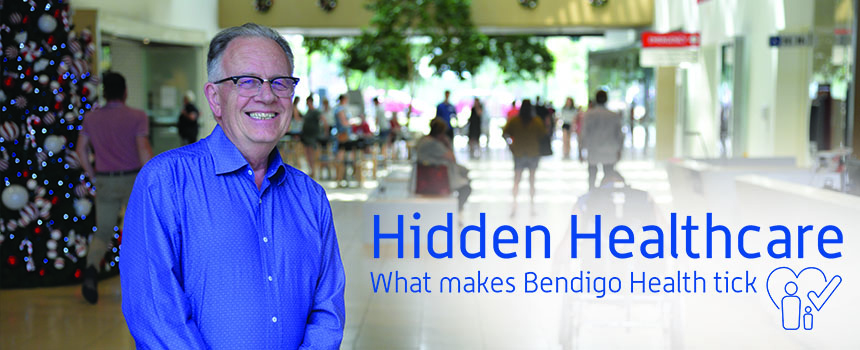 Peter Faulkner has helped rebuild the reputation of Bendigo Health after a turbulent period for the health service.
Peter Faulkner has helped rebuild the reputation of Bendigo Health after a turbulent period for the health service.
A brief stroll around the hospital with chief executive officer Peter Faulkner provides an illuminating insight into his leadership style.
Recognised by most, he says hello and has a brief chat with people he’s interacted with during his 10 years at Bendigo Health.
“I get great joy from people, meeting people, listening to them and sharing their life experience,” he said.
“My greatest sadness is that I’d really like to be able to match 4000 names with 4000 faces and sometimes it’s a bit of a struggle.”
Peter considers himself a man of the people who is tasked with doing the very best for the people.
“I’m just another health worker that found themselves in the right place over various stages of their career and have been given the opportunity to make a difference,” he said.
The reality is more complicated and not entirely determined by chance.
After a number of years in general manager and executive director roles in various healthcare organisations, Peter was tasked with delivering the Bendigo Hospital project.
It was once the project was successfully delivered that things became more challenging.
Peter was asked to become the acting CEO while the current CEO was being investigated by the state’s corruption watchdog, IBAC.
“We all felt a bit bruised, a bit damaged, a bit let down. I saw it as an opportunity to rebuild that trust in the organisation,” he said.
The uncertainty over the leadership of the organisation during the investigation was problematic for Peter.
“I was technically still reporting to the CEO but I had to do what was in the best interests of the organisation. It wasn’t difficult organisationally, probably more difficult personally to try and manage a relationship with a person who has been your boss for the best part of a decade,” he said.
A cautious approach was required during this ‘acting’ period, he said.
“In hindsight if I had of been CEO from day one rather than interim CEO I possibly could have done things a bit quicker. But you take a bit of time to pace yourself knowing that what you put in place may not be what endures which is not fair to staff to have change then more change.”
Now, just over two years after being appointed CEO, Peter believes the organisation is repairing itself and the changes put in place are beginning to mature.
Opening lines of communication to the CEO, improving transparency, developing an integrity framework and the creation of clinical directorates across clinical operations areas are measures Peter believes will benefit the organisation in the long-term.
“Changing the structure was about trying to build partnerships between medical, nursing and allied health so they are participating in communication, policy and the management of our service. It’s a significant change but it will take a little while for that to mature,” he said.
Peter’s open door policy does have its down side.
Roughly 100 emails a day and countless meetings takes up most of his time.
“The world has changed, it’s now a world of email and it’s relentless and it’s every day and so just keeping up with that burns hours in the day,” he said.
“Health services are meeting rich, it’s a reflection of the fact they’re complex human systems which are driven by communication. Although we are at times critical of the amount of time invested in meetings, they serve a vital function in human systems.”
The meetings, emails and offsite work in Melbourne or the region restrict the amount of time Peter has available to visit wards, departments and engage with staff.
“Everybody would like all the bosses to come and work with them on the floor to see how busy it is and how tough it can be at times and whilst that would be desirable, it’s not easy to do. Having worked on the floor, I know that at times it’s an extremely pressured business,” he said.
Looking ahead, Peter sees the transition to the electronic patient record next year, providing greater clinical connectivity in the Loddon Mallee Region and enhancing the clinical research capacity of Bendigo Health as the next challenges.
But whichever challenge is pursued, Peter’s strategic focus will always be informed by people’s experiences, whether that’s staff or consumers.

For more in our Hidden Healthcare series, click the link below.
Hidden Healthcare